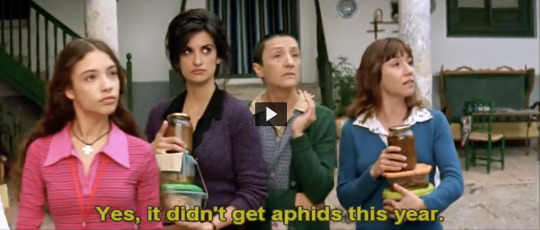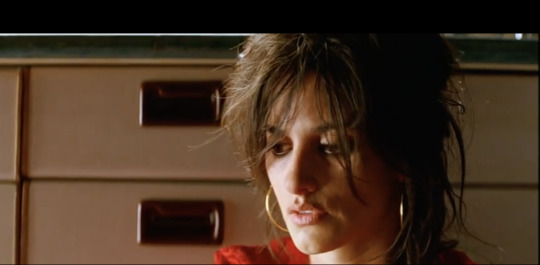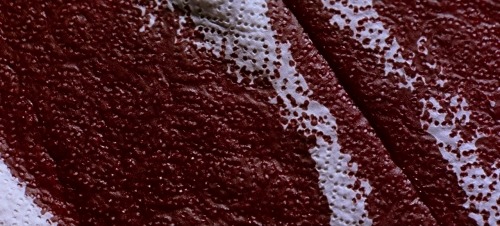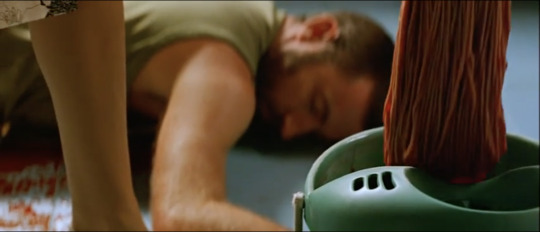Text
Final Assignment
A holistic analysis of the film "Volver" by Pedro Almodóvar
Pedro Almodovar's film "Volver" is a vivid portrait of the intricate relationships that exist within families and the unbreakable bond that ties mothers and daughters together. Set in Madrid and the Spanish countryside, the film follows the story of Raimunda, played by Penelope Cruz, as she navigates the challenges of family, love, and loss. With Almódovar's signature blend of drama, humor, and sensuality, "Volver" is a film that immerses you in its world from the first frame, and leaves a lasting impression long after the credits roll.
The following is a holistic analysis of the film in accordance with the six perspectives of visual analysis.
Historical:
To truly grasp the historical context of "Volver," it is essential to examine Almodóvar's filmmaking career leading up to this particular film. Almodóvar emerged as a prominent figure in the "Movida Madrileña" movement during the transition from Francisco Franco's dictatorship to democracy in Spain. This artistic and cultural movement, which took place in the late 1970s and early 1980s, embraced freedom of expression, creativity, and a rejection of the repressive past. Almodóvar's early works, such as "Women on the Verge of a Nervous Breakdown" and "Tie Me Up! Tie Me Down!," showcased his unique blend of melodrama, comedy, and vibrant visuals that emerged as a result. These films’ bold challenge to social norms and exploration of “taboo” subjects reflected the changing Spanish society.
Continuing his exploration of female characters, Almodóvar portrays complex and strong female characters in "Volver" who navigate their lives with determination, despite the hardships they face. This portrayal aligns with the broader historical context of the feminist movements and the growing visibility of women in Spanish society. "Volver" also highlights the importance of storytelling and the interconnectedness of the past and the present. Almodóvar weaves a narrative that intertwines multiple generations, revealing how the actions and secrets of the past continue to impact the lives of the characters in the present. Through his storytelling, Almodóvar emphasizes the power of memory, personal history, and the need to confront and reconcile with one's past.
Cultural:
Almodóvar weaves the elements of family dynamics, death rituals, female empowerment, and visual aesthetics into a poignant narrative that serves as a testament to the complexities and richness of Spanish culture while also shedding light on universal themes such as love, loss, and ultimately resilience.
One of the key cultural contexts of the film is the importance of family and community ties within Spanish culture. The film revolves around a group of women who are portrayed as strong, resilient, and deeply connected to one another—serving to highlight the significance of such familial bonds within Spanish society. The film also explores the idea of women as the backbone of the family, embodying strength and a deep sense of duty to their loved ones. Accordingly, the film challenges traditional gender norms, presenting women as central figures and shedding light on their struggles, resilience, and agency; particularly in the face of adversity, as mentioned before.
Another culturally significant consideration is the theme of death and mourning in Spanish culture. The view of death as a communal experience in Spanish culture plays a significant role in the rituals and traditions surrounding mourning. Almodóvar captures this aspect in the film’s opening sequence, depicting women cleaning the graves at the cemetery, paying homage and respect to generations past. This scene also establishes the idea of death and the dead as active parts of their lives as well as the use of wind as a motif to visually represent supernatural presence.
Of course, the film also emphasizes the importance of remembering and honoring the deceased, while also highlighting the supernatural elements associated with death through the character of Irene, who returns as a ghost.
Furthermore, Almodóvar utilizes his signature visual style to enhance the cultural context of the film. The vibrant and saturated colors, combined with the use of flamenco music, create a distinctly Spanish atmosphere—reflecting the passion and vivacity often associated with the culture. The use of traditional Spanish houses, with their ornate interiors and courtyards also contributes to this.
Moreover, Almodóvar’s incorporation of magical realism works to blur the line between reality and fantasy, which is a technique commonly found in Latin American literature. His use of magical realism adds depth to the cultural aspect of the film, allowing for a deeper exploration of emotions, spirituality, and the interconnectedness of life and death.
Ethical:
The topic of death naturally presents ethical concerns. One of the notable aspects of Almodóvar's treatment of death in "Volver" is his ability to infuse it with a sense of humanity and empathy. Rather than depicting death as a mere plot device or a source of shock value, Almodóvar delves into the emotional complexities and consequences that death brings to the lives of the characters. By doing so, he humanizes death and highlights the universal experiences and emotions associated with losing a loved one. This considerably ethical approach allows the audience to connect with the characters on a deeper level and fosters a greater understanding of the impact of death on individuals within such communities.
The element of sexual abuse present within the film also calls for Almodóvar to handle the subject respectfully; maintaining the dignity of those abused by portraying such things accurately (though I cannot give too much credit) so as to not promote false narratives about victims or perpetrators of abuse. While the female characters in the film are portrayed as individuals who have endured hardships, they also possess the strength to triumph over them. By highlighting the agency and resilience of women and acknowledging the insidious nature of men, the film successfully challenges prevailing stereotypes that paint women as helpless victims and men as justified abusers. Even more, the dismissal of men's relevance in this film liberates it from becoming a polemic against them, choosing instead to delve into the profound exploration of female camaraderie and determination.
Technical:
The film was shot on 35mm film, using the Panavision Panaflex Platinum camera, which is a widely used camera in the film industry. Almodóvar worked with his regular cinematographer, Jose Luis Alcaine, who has collaborated with him on numerous films (https://shotonwhat.com/volver-2006).
Much of the film’s strength comes from its cinematography. The following is a brief breakdown of such:
Color:
As is true of his other works, Almodóvar’s use of color is an essential aspect of the film's visual language. The colors employed are not merely aesthetic choices but serve as powerful symbols, enhancing the narrative and serving to evoke profound feelings within the audience. The use of red (a signature of Almodóvar’s) in both costume and set design, for instance, effectively conveys danger, love, life, and death—the ties which bind the characters together. Furthermore, the film’s rich and vibrant color palette is evocative of the equally vibrant and colorful aesthetics of Spain, creating a sense of nostalgia for the country’s past as well as adding to the film’s overall cultural richness (see Figure 1).
Figure 1:

Color is also used in the film to distinguish and highlight the personalities of the characters. At times, the female characters, in particular, don bright and flamboyant dresses and other assorted outfits that symbolize their femininity and strength (see Figure 2). The distinct colors of their attire not only differentiate them visually but also contribute to the depth of their personalities, emphasizing their individuality and the complexities that lie within (see Figure 3). Moreover, the use of intense colors throughout the film creates a visual contrast when juxtaposed with darker or more muted tones, further imbuing the film with a sense of depth and complexity (see Figure 4).
Figure 2:

Figure 3:

Figure 4:

In addition to the color red, the color blue is featured prominently in scenes dealing with loss, mourning, and mortality. Associated with water and the sky, the color serves as a symbol of transformation and cleansing, possibly even freedom. As such, it is the primary color worn by Irene who gained all three through her own death and that of others (see Figure 5). Blue is also present in key scenes such as Raimunda cleaning up Paco's body in the kitchen (see Figures 6 and 7). Here, the color blue represents both literal cleansing as well as the symbolic cleansing of the burdens and secrets of the past. Through the act of cleaning, Raimunda not only scrubs away the physical remnants of death but also purges herself and her family of guilt, pain, and suppressed emotions of past and present.
Figure 5:

Figure 6:

Figure 7:

Another use of the color blue is in the opening scene in which the buckets used by the women cleaning the graves are all the exact same hue of blue (see figure 8), once again symbolic of cleansing. However, such imagery also evokes the color’s connotation of loyalty; reiterating the dedication the living has to the dead. This idea of loyalty and the identical buckets also work to unify the women in the scene as various gestalt laws are employed to suggest this relationship such as the law of similarity, common fate, and symmetry (the similarly dressed women making similar movements each spaced and stationed at the neatly ordered graves).
Figure 8:

The various uses of color imply that death is not merely an end, but rather a transformative process that can lead to liberation and renewal. By incorporating blue into scenes associated with loss and mourning, Almodóvar suggests that these experiences can be catalysts for personal growth and liberation from emotional burdens. At the same time, he also conveys the “burden” bestowed upon the dead by the living.
Lighting:
The film uses warm and cool color temperatures to create a visual contrast between different settings and moods. For example, many of the interior shots are lit with orange and yellow hues, which create a warm and intimate atmosphere (see Figure 9). In contrast, scenes such as Raimunda with Paco in bed (see Figure 10) are lit with cool, blue tones, which add to the sense of emotional distance and detachment of the scene.
Figure 9:

Figure 10:

The film also uses natural light to great effect, especially in the scenes that take place outdoors (see Figure 11). Such natural light is often used to emphasize the film's elements of realism.
Figure 11:

Camera Work:
The film was shot on 35mm film, using the Panavision Panaflex Platinum camera, which is a widely used camera in the film industry. Almodovar worked with his regular cinematographer, Jose Luis Alcaine, who has collaborated with him on numerous films (https://shotonwhat.com/volver-2006)
The camera often moves in a fluid and dynamic way, following characters as they move through different spaces. This creates a sense of energy and momentum and also helps to establish a sense of place and atmosphere (as seen in the beginning scene of Augustina walking through the cemetery). Many of the tracking shots in the film are filmed at eye level, creating a sense of intimacy and familiarity with the characters.
A variety of camera angles are used throughout the film to emphasize different aspects of the story. For example, in a scene where Raimunda's sister, Sole arrives at the funeral at Augustina’s house, the camera shows her point of view as she eerily makes her way through the house and catches a glimpse of her mother. In doing so, Sole’s anxiety and unease are transferred to the audience, creating suspense.
Overhead shots are used in the film to create a sense of detachment and objectivity as if the camera is an omniscient observer. For example, when Raimunda is cleaning the kitchen after Paco is killed, the camera takes an overhead shot, showing the body and the surrounding pool of blood from a detached perspective (see Figure 7). This contrasts with the close-up shot of Raimunda as she zips up his fly (see Figure 12). Here, the focus is on Raimunda’s face, emphasizing the emotions she is feeling. Her actions (zipping Paco’s fly) are implied through the flipping of the body, the direction of her eyes, her limited movements, and the sound of the zipper. Throughout the cleaning scene, the overhead shots are cut with close-ups of bloodied paper towels and other miscellaneously framed shots of bloodied cleaning supplies (see Figures 13 and 14), possibly to mimic Raimunda’s state of mind as she switches between dissociation and visceral awareness of the situation. This also works to emphasize the connection between Raimunda’s cleaning job at the airport and her matriarchal duties.
Figure 12:

Figure 13:

Figure 14:

Close-up shots are heavily employed throughout the film. Another instance is when Raimunda is cleaning the blood off of the knife in the sink (see Figure 15). This shot is contrasted with the earlier over-head shot of Raimunda cleaning the same knife at the sink, just after she had told Paula to close her legs (see Figure 16). The over-head shot frames Raimunda to emphasize her chest, giving the audience the point of view of looking down her shirt. In doing this, Raimunda is being sexualized the same way her daughter just was. This, when paired with the murder weapon, creates a full-circle moment that completes the earlier foreshadowing.
Figure 15:

Figure 16:

Several extreme long shots and wide shots are used to show the characters in their environment and convey a sense of space and scale, specifically when driving through the field of windmills (see Figures 17 and 18).
Figure 17:

Figure 18:

Critical:
“Volver” was met with critical acclaim, receiving nominations for numerous awards such as the Golden Globes and Critics Choice Awards for Best Foreign Film. It also won several awards for Best Screenplay and both Almodovar and Penelope Cruz were nominated and awarded for their accomplishments regarding the film. The success of the film was due in large part to the following:
Almodóvar's Aesthetic Mastery:
Pedro Almodóvar's unique visual style is prominently displayed in "Volver," combining vibrant colors, flamboyant production design, and a keen attention to detail. The film's saturated palette creates a visually stimulating experience that contrasts the seemingly mundane setting of a Spanish village. Almodóvar's deliberate juxtaposition of striking visuals with everyday scenes amplifies the emotional depth of the characters' journeys, enveloping the audience in a world that blurs reality and fantasy.
Female Empowerment and Identity:
"Volver" is a testament to Almodóvar's commitment to portraying strong, multifaceted female characters. The film's narrative primarily revolves around Raimunda and her resilience in the face of familial tragedy. Almodóvar explores the complexities of womanhood, presenting female characters who challenge traditional gender roles and societal expectations. Raimunda's journey from victimhood to empowerment, her ability to support her family, and her unwavering determination portray a narrative of female strength and agency.
Cultural and Social Commentary:
Almodóvar subtly addresses various cultural and social issues prevalent in Spain. The film explores themes of familial duty, highlighting the traditional values and close-knit communities of rural Spain. Almodóvar uses the backdrop of the small village to examine the intersecting roles of religion, superstition, and patriarchy, ultimately questioning their influence on women's lives. By intertwining these societal elements, Almodóvar presents a critique of the limitations imposed on women and the importance of breaking free from oppressive norms.
The Intricacy of the Narrative:
"Volver" showcases Almodóvar's ability to interweave multiple storylines and narratives seamlessly. The film oscillates between moments of drama, suspense, and dark comedy, engaging the audience through its intricate plot twists and character dynamics. Almodóvar's direction ensures that each character's arc is given due attention, creating a multi-layered scape that sees the past repeat itself, the dead come back to life, and the painfully concealed return to the fore.
Personal:
I will admit that most of the praise given throughout this analysis is in regard to the film’s cinematography. Almodóvar’s mastery of color, lighting, camera techniques, composition, and genre-blending elevates the film beyond its narrative and makes it a visually captivating experience. Objectively, I can understand the acclaim the movie received regarding its screenplay. However, it is not a movie that I would personally consider note-worthy outside of its visual language.
I believe that part of my opinion stems from the cultural/language barrier. I have not watched many foreign comedies, but the ones that I have watched I did not find all that funny. Because humor relies so heavily on social and cultural awareness, when that awareness is absent, often so is the humor.
I had no issue with the subject matter, in fact, I can relate to it on multiple levels. However, I found that my emotions were more wrapped up in the visuals rather than the narrative. Overall, I think it comes down to it just not being my cup of tea.
12 notes
·
View notes
Text
Assignment #2
A semiotic analysis of tampon advertisements' exploitation of women
*the author of this post recognizes that menstruation is not only a female issue but is rather something that affects all those who have uteruses, regardless of gender. However, for the purposes of the following analysis of the gendered stereotypes present in the specified advertisements, menstruation will be discussed in the context of the female gender.
Tampon advertisements have long been shrouded in coy euphemisms and subtly suggestive imagery. While at face value these tactics appear to be a clever way to give a wink and a nudge to the female audience, the real strategy at play is something much less lighthearted. When tampons first arrived on U.S. shelves in the mid-1930s, government regulations and social mores made advertising the product a difficult task. Instead of trying to refute the stigma surrounding menstruation, tampon advertisements chose to use it to their advantage and continue to do so to this day. Through the employment of rhetorical devices such as euphemisms, metaphors, and personification, tampon advertisements exploit gender stereotypes and social taboos to persuade consumers to not only view menstruation as a problem but to believe that it is an issue only their products can remedy.
According to Johnston-Robledo and Chrisler (2020), menstruation meets all three of the criteria of stigma as determined by the sociologist Erving Goffman. First, because menstruation is unique to the female sex, it serves as a marker for the “tribal” identity of femaleness (Johnston-Robledo & Chrisler, 2020). Second, the hygiene and ritual practices surrounding menstruation imply that menstrual blood is viewed as dirty or unwanted (Johnston-Robledo & Chrisler, 2020). This speaks to menstruation as an abomination or “defect” of the body. Lastly, given such aversions to menstrual blood, “even reminders of such (e.g., tampons) can lead to avoidance and social distancing, which suggests that menstrual blood may serve as a blemish on women’s character” (Roberts et al., 2002, as cited in Johnston-Robledo & Chrisler, 2020). The fulfillment of all three of Goffman’s criteria of stigma makes menstruation a particularly potent source of female culture and strife.
In the context of advertising, messages are both explicitly and implicitly sent through the combination of symbols, objects, and words to communicate and connect with a target audience. Semiotics suggests that the extent to which a symbol is comprehended by the interpreter is dependent upon a number of factors. Namely, a person’s culture can heavily influence the way they receive and understand messages. Because of this, it is crucial that advertisements understand the culture of their intended audience. The following analysis of three Tampax advertisements will demonstrate how Tampon ads utilize signs, symbols, and semiotics as a whole to construct messages in the pursuit of maximum comprehension and compliance.
In 1994, Tampax released a commercial for their new product, Tampax Compak. As its name implies, the product’s new design offered a compacted applicator. The commercial opens with a slightly more upbeat version of Billie Holiday’s “Ain’t Nobody’s Business If I Do,” repeating in the background. Throughout the commercial, various women are shown moving about in what is suggested to be their natural habitat. A few of the interesting shots portray several women in gowns, one in a bikini jumping into a pool, and most notably, a group of scantily-clad women running “Baywatch-style” down the beach (see Figure 1). A voice-over toward the end of the commercial boasts “nobody knows you are carrying it or wearing it." It is apparent through the commercial’s scarce mentions of the product and the numerous depictions of women frolicking in their leisure, that the advertisement is actually selling the lifestyle of the women using the product rather than the product itself. Additionally, the voiceover as well as the absence of any mention of the word “period,” conveys to consumers that periods are supposed to be kept secret and implies that one would be subjected to shame or negative reactions if anyone were to find out they were on their period. By conveying this message, the advertisement frames the compact feature of the product as a solution to the shame that they have just sold to its audience. A compact applicator doesn’t offer any benefit to a woman’s health, nor does it truly serve any purpose. It only matters when you believe that discretion is a priority.
Figure 1

In 2008, Tampax launched one of its most popular campaigns entitled “Outsmart Mother Nature.” As seen in Figure 2, each commercial that ran as a part of the campaign featured a middle-aged woman outfitted in a green tweed suit, who served to represent the Mother Nature referenced in the campaign’s title. Already, the euphemistic personification of a woman’s period as “Mother Nature” highlights the off-limit speech that exists within the industry. Additionally, while a woman’s period is an indication of her health and maturity that some meet with celebration, the campaign’s title suggests that the biological event is in fact a problem that must be outsmarted.
Figure 2

In a commercial titled “Photoshoot” that ran as a part of the “Outsmart Mother Nature” campaign, Mother Nature visits a model on the set of a photoshoot to deliver to her a “monthly gift” which is neatly concealed inside a pink and red adorned giftbox (see Figure 2). The commercial opens with loud strobing music as viewers are shown flashes of models dressed in all white, spliced with other images depicting colors of silver and white (see Figure 3). As Mother Nature enters the set, the music screeches to a halt and she informs the model that it’s time to end the shoot, alluding to the gift in her hand. The model rebuts, claiming that because she has the new Tampax Pearl, her period doesn’t have to interrupt her life. The commercial closes with an image of the product and a voiceover repeats the campaign’s slogan, “Outsmart Mother Nature.”
Figure 3
Throughout the commercial, the audience is presented with several layers of euphemisms. At no point are the benefits of the product explicitly stated. Rather, the advertisement uses symbols and codes to convey to viewers the hindrances of menstruation and leaves the viewer to draw her own conclusion. To start, the woman referred to as “Mother Nature” represents the giver of a period, and the pink and red box that she carries is used to represent that said period. Additionally, the use of the color white evokes notions of purity and cleanliness. A study on the depiction of women’s bodies in commercials explains:
Consistent with prior research, disidentifying clothing was commonly used in the advertisements. Depicted women were often dressed in tight and/or white clothing. Prior research has contextualized the use of disidentifiers as a means of maintaining secrecy and avoiding shame since the advertised products are not visible under tight clothing and will prevent leaks that could soil white clothes. (Erchull, 2011)
The use of white clothing suggests that a woman would or should fear bleeding onto her clothes while menstruating. In the commercial, the model’s white clothing is used to communicate to the audience that she is free from the anxieties of wearing white on her period, suggesting that Tampax Pearl lets her be carefree. Lastly, the advertisement’s use of a model, a golden standard of beauty in the U.S., further reinforces the idyllic narrative of Tampax Pearl.
As a part of the same “Outsmart Mother Nature” campaign, Tampax also produced several print advertisements in which the same implicative strategy is used to convey to consumers the benefits afforded to them by Tampax tampons. In one particular ad (see Figure 4), neither Mother Nature, her monthly gift, nor any other woman is present. Instead, the ad depicts a tall, dark, and handsome man outfitted in a familiarly white suit.
Figure 4

The motel room in which the man stands is decked out with all of the makings for a romantic Valentine's Day—dark red upholstery, roses, chocolate, and a man cast in an angelic glow. The only thing missing is his date, who, as suggested by the ad copy, has been afflicted by Mother Nature’s monthly gift (i.e. her period). The beaming light and the white of the man’s suit work together to cast him in an image of purity that stands in stark contrast to the red hue of Mother Nature’s storm that brews just behind him. The implication of this is that the man is “good” and that Mother Nature, and consequently the absent woman, are “bad.” In a study that examined women’s experiences with sex during menstruation, over half of the surveyed participants indicated that they experienced negative reactions to sex while menstruating (Fahs, 2020). In the fashion of the old Nature versus Culture dichotomy, this advertisement exploits this facet of menstrual stigma by implying that a woman’s period impedes intimacy. Unlike the “Photoshoot” commercial, this print ad doesn’t make any explicit reference to tampons or periods. However, the Tampax logo affixed beneath the campaign’s slogan in the corner of the ad manages to still suggest that even if you can’t stop Mother Nature, you can at least outsmart her by using Tampax.
Today, almost a century since the modern tampon first hit the U.S. market, tampon ads are still beating around the bush. Issues of censorship and the social taboo surrounding periods, while progressive in relation to the ‘30s, continue to persist nonetheless. The potent stigma surrounding menstruation presents tampon advertisements with a distinct opportunity for the maximization of their efficacy. Thus far, tampon ads have capitalized on women’s shame by gift wrapping it in a little pink and red box. However, analyses such as this may hopefully indicate that the time for clever equivocation at the expense of women is no more. The treatment of women’s periods in the media has become palliative at best and it’s time for a new strategy.
References:
0 notes
Text
Assignment #1
Semiotic analysis of four Adbuster spoofs
Spoof ads aim to discourage people from using or buying the advertised product and typically offer some sort of commentary on the issue. They are usually parodies of the original advertisements and often pervert the themes and motifs used within them.
The first advertisement I have chosen to analyze is a spoof ad for Marlboro:

The goal of this advertisement is to show the bleak reality of smoking and it does so by parodying the quintessential cigarette brand, Marlboro. The Marlboro brand relies on its carefully constructed image to sell its product. The brand’s advertisements use rugged cowboys and demanding scenery to showcase what they call “Marlboro country” and suggest that the lifestyle of those who smoke Marlboros is that of freedom, adventure, and independence. This spoof advertisement parodies this concept to suggest what true Marlboro country looks like.
Straight away, the headline “Welcome to Malboro Country” tells you that this ad is playing off of the Marlboro brand. In addition to being in the same font and color red as the original Marlboro advertisements, the phrase “welcome to Marlboro country” was a common feature in older Marlboro advertisements. The cloud of smoke and the blue wall is also reminiscent of the blue skies commonly featured in Marlboro advertisements. Additionally, whether intentional or not, the missing “r” in “Malboro” speaks to its inauthenticity, suggesting that the advertisement is a spoof. The inclusion of the headline and other imagery similar to the original Marlboro advertisements uses metonymic and analogical code to cause the viewer to compare this advertisement to the original Marlboro ads. In doing this, the discrepancies between the two become much more apparent and ultimately enhance the message.
As the viewer makes their way down from the headline, the seemingly white and blue sky begins to fade into a grey (symbolic) that speaks to the dreary reality of the huddled group of people standing outside of the building. The cigarette in each of their hands (iconic) and the smoke trailing from them (indexical), indicate that they are smoking cigarettes and place them in the position of the Marlboro Man. The individuals’ proximity to each other as well as their attire, suggests that they are coworkers who work in an office setting and that they must be out on a smoke break. Additionally, their body language (indexical), in combination with the surgeon general’s warning that reads “smoking causes hypothermia,” indicates that not only is it cold, but that they are succumbing to the elements. All of these components form a condensed code that conveys the reality of smoking as bleak and unappealing. Through metonymic code, it is suggested that this bleak reality is in fact “Marlboro country.”
The next ad I have chosen to analyze is a Calvin Klein spoof:

The intention of this spoof ad is to make commentary on the fashion industry and its exploitation of women. The ad features a package of raw chicken that is stylized to resemble the brand Calvin Klein, with emphasis given to the brand’s “CK” lettermark (symbolic). Through displaced code, the pieces of chicken symbolize the women depicted in the brand’s advertisements, speaking to the idea of their body parts being separated from the whole and used as marketing tools. Once one is aware of the comparison being made, it becomes apparent that the descriptive phrases on the packaging are actually being applied to the women and the “grade A design” symbol suggests that those characteristics are the industry’s ideals. The application of common descriptions of premium meat to women highlights the ridiculous physical expectations for Calvin Klein models and calls attention to the dehumanizing nature of the brand’s advertisements. For those who have prior knowledge of Calvin Klein ads, the beauty standards of women, and the inhumanity of mass production, all of the elements present in the spoof ad create a condensed code that sends the message that fashion treats women’s bodies like commodities.
The third ad I have chosen to analyze is a spoof of an ad for Berluti, a men’s luxury shoe and leather goods brand:

The ideology behind this spoof is that buying luxury brands perpetuates consumer capitalism. The leather shoe and the brand’s name serve to symbolize the luxury brands and goods in question. The image of luxury is reinforced by the pristine condition of the leather shoe, indicated by its shine (indexical), which suggests that the shoe is freshly polished. Additionally, the luxury brand name of Berluti, in what appears to be a slightly altered Garamond typeface, typical of luxury brands, speaks to the luxurious image as well. The “place tongue here” (symbolic) alludes to the idea of bootlicking, which symbolizes submission, servitude, and obedience. So, because the “place tongue here” is positioned at the tip of the luxury shoe, it creates a condensed code that suggests that consuming luxury items makes you a servant of capitalism.
The final ad I have chosen to analyze is a spoof of a Tic Tac ad:

The intention of this spoof is to critique the nation’s increasing reliance on prescription drugs to enhance productivity and performance. The replacement of Tic Tacs with Adderall pills uses analogical code to equate our conception of stimulants to mints, suggesting the normalization and trivialization of prescription drug use. The ad’s slogan, “for when you need to freshen your mind,” further suggests that stimulants are used as quick fixes to a tired mind similar to the use of a tic tac for fresh breath. The use of a well-known brand in the spoof highlights the contrast between the expected and the reality, emphasizing the absurdity of the situation. Additionally, the sterile white and various green colors (symbolic), give the ad clinical or medical air. Together, all of these elements create a condensed code that conveys to the viewer a critical message regarding society’s attitude toward prescription stimulants–a message that is particularly salient given the current national Adderall shortage.
0 notes